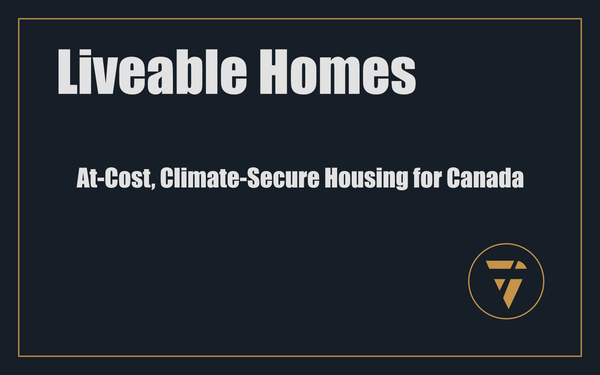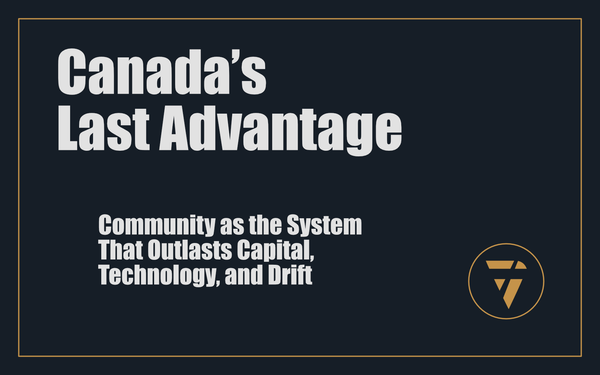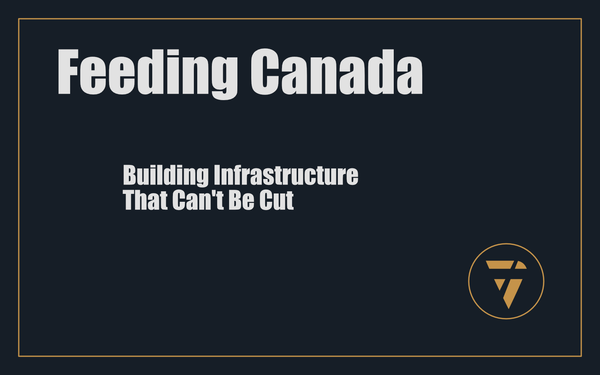This Is Not a Home, It's a Hazard

Canada Is About to Mass-Produce Its Next Failure
Mark Carney’s housing plan has the tone of a solution and the architecture of a mistake. It’s fast. It’s photogenic. It echoes the postwar era in all the ways that feel safe.
And it will fail.
Not because it lacks vision, but because it’s staring in the wrong direction. Nostalgia is not infrastructure. And the past does not hold the answer to a climate, capital, and construction reality it never had to survive.
This is not the 1940s. The threats are different. The economics are different. The stakes are higher.
Yet what’s being proposed is a scaled-up replay of a housing model that was never designed for energy volatility, climate trauma, or material fragility. It was designed to get people indoors, not keep them alive once they were.
That distinction now matters.
Because in 2021, during the BC heat dome, 619 people died in their homes. Seniors. Poor. Alone. No air conditioning. No thermal protection. No way out.
They weren’t reckless. Their homes were.
And we’re about to build tens of thousands more just like them.
The failure isn’t hidden, it’s designed in.
The catalogue looks modern. The renderings are tight. But the structural core is already obsolete. The entire building strategy is pinned to climate zone data from 2018, data that has already failed to predict the last five years of warming. Every house built under this plan assumes a climate that no longer exists. And that’s not a flaw. That’s a feature of the system.
The goal is speed. The incentive is volume. The driver is economic stimulation. And in that game, thermal resilience, grid independence, and material survivability are not metrics. They are cost centres.
Which is exactly how we got here.
This isn’t housing policy. It’s a cashflow strategy, and Canadians are the exit liquidity.
Every unit built to a sub-survivable standard becomes a long-term liability disguised as an affordable asset. It feels good in the short-term. It wins headlines. It sells progress. But it hands families a structure that will leak value, demand constant maintenance, and fail the first time the power grid chokes under a simultaneous cooling load during a July heatwave.
Because that’s what’s coming. Not maybe. Not eventually. Already. And these homes are not ready. The homes we have now aren't ready.
So let’s stop pretending this is about solving a crisis.
It’s about moving money.
Developers get subsidies. Suppliers get contracts. Builders get permits. Banks get interest.
And the citizen gets a home that won’t protect them when it matters most.
We’ve seen the alternative. And it works.
In Kitchener-Waterloo, under a Passive House retrofit model, homeowners would reduce energy use by 90%, increasing home value by 40%, and doing it all with no debt and no upfront cost.
This isn’t fantasy. It’s been modelled, costed, and deployed.
It holds temperature during blackouts. It repels moisture. It converts sunlight. It’s more affordable to live in. And it’s designed to keep people alive, not just dry.
This is what Canada should be scaling. This is what public capital should fund. Not legacy catalogue homes that anchor families into fragile futures.
The profit motive isn’t the problem. It’s where the profit goes.
In the retrofit model, every dollar stays with the citizen. Every improvement builds equity. Every reduction in energy cost frees up capital. And the system works because it’s circular, not extractive.
This model? The money flows out.
Land contracts → developers. Material supply → multinationals. Debt service → institutional capital. None of it stays. None of it builds sovereign value. It’s a subsidy pipeline disguised as nation-building.
And in five years, we’ll have rows of “affordable” homes too expensive to maintain, too hot to survive, and too broken to resell without another round of public funding.
This is not housing. It’s hazard deployment.
We don’t need more homes. We need homes that work. That hold value. That withstand heat, cold, flood, flame. That give families leverage, not loss.
What Carney is proposing is mass production. But not of safety. Not of equity.
Of failure.
At national scale.
And we will all pay for it, twice.
Once at the build.
Then again when they break.
This is what I’m working on. Tell me what you think, I enjoy the conversation! Subscribe and follow the work in real time.
Thanks!
B

Carney’s housing plan looks modern — but it’s built on data from 2018, designs from 1946, and climate assumptions that will get people killed.
We’re scaling homes that can’t survive the heat, can’t hold value, and can’t protect the people inside them.
It’s not a solution. It’s a transfer of public money into private hands — and when the power goes out, we’ll see the cost.
Read this before the first shovel hits the ground:

PS -







